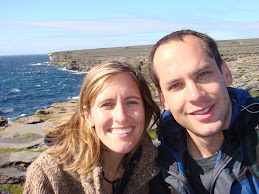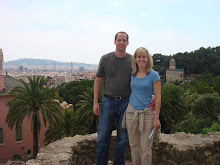

County Kerry consists of the famous Ring of Kerry, as well as the bucolic Dingle Peninsula. We stayed in the city of Cork, located about an hour east of the Ring of Kerry, which made for a good base to also reach western County Cork sites, as well as its southern coast.
Heading south from Galway, we stopped at Carrigafoyle Castle and Ardfert Cathedral on our way to the Dingle. We spent our first day driving around the Dingle Peninsula, and first stopped off in the coastal town of Dingle, the home of Fungie, the dolphin, but didn't take the boat ride out to see him. (Full refunds advertised if the dolphin doesn't come out to say "hi!"). Heading west along the coastal highway R559, we visited Dunbeg, a promontory fort along the coast. Two sheep charged up onto rolling hills near the fort and butted horns right in front of Damon. They weren't camera shy. Nearby, the southern slope of Mount Eagle falls steeply away to the sea to form Slea Head, the most south-westerly point of the Dingle Peninsula. At Slea Head, where the road turns to head north on the peninsula, there is a white sculpture of the crucifixion known locally as the Cross with gorgeous ocean views. As soon as we turned the corner, the Blasket Islands came into view. Then we drove to Dunmore Head, mainland Ireland's most westerly point, for a picture and more views of the Blaskets.
Dingle Peninsula (+ northern County Kerry sites):
The next day, we did a walking tour of Cork, the second largest city in the Republic of Ireland. We saw Miller Genuine Draft signs in the pub windows and three guys carrying cases of MGD on their shoulders. Then we learned that Beamish & Crawford, a huge brewery in Cork city, brews MGD and many other beers near the river in Cork. I emailed my step-father, Bill Crawford, to make sure he traces his lineage back to his brewmaster relatives and gets some royalties from the bustling beer business they've got over here!
Cork City Photo Album:
Then we drove to Blarney Castle, so that Lisa could kiss the Blarney Stone, which is said to bring the gift of gab to those who kiss it. (Like that is needed...) The castle is surrounded by beautiful gardens, where we saw exotic plants that looked like the one from the movie, "Little Shop of Horrors." There were also Wishing Steps, which you're supposed to climb up and down backwards, with your eyes closed, to have your wish granted -- and a place called the Witches Kitchen, a gigantic, moss-covered tree with an old cave dug under it with ruins of a fireplace.
We spent the rest of the day in west County Cork. We toured the Jamesons Old Midleton Distillery in Midleton, where Wash Still, the largest pot still in the world, is located. It was built in 1825 and has a capacity of 31,648 gallons. Lisa participated in the Whiskey Challenge, a comparative tasting of whiskies from Ireland, Scotland and the U.S. Lisa learned she doesn't like whiskey straight, and was severly outpaced by the Polish, Irish and English folks who also participated.
Close to sunset, we drove through the town of Cobh, the pretty seaside town that was the Titantic's last port of call before it sank in the Atlantic. We spent the evening in Kinsale, considered one of Ireland's most charming villages, and it didn't disappoint. Kinsale sits at the mouth of River Bandon and is known for its yachting marina and annual food festival. We visited Charles Fort, on the coast just outside of town, before doing a walking tour of Kinsale and having dinner at a pub.
County Cork Day Photo Album:
We saved the best for last, spending our final day driving the Ring of Kerry. The Ring of Kerry is a tourism trail on the Iveragh Peninsula. We stopped first at Torc Waterfall, located at the base of Torc Mountain, about five miles from Killarney, before driving through the town of Killarney to Muckross Estate inside Killarney National Park. The park spans more than 25,000 acres and includes the Lakes of Killarney. Amazing views. We walked 1.5 miles along a trail to see the ruins of Muckross Abbey. We then drove to Ross Castle on the lake shore, where you can rent boats and row out to the little islands in the middle of the lake. (If only we'd had more time and less rain.) The highlight of the trip for both of us was Ballinskelligs Bay, where we visited a sandy beach that's home to Ballinskelligs Castle and Priory. The stones and pebbles on the beach were a beautiful lavender color. The tide came in while we visited the priory ruins, so we had to get a little wet in order to reach our car. The mountain and ocean views were absolutely breathtaking! Would anyone who saw these turquoise waters in a photo think this is Ireland's coastline? Check out the slide show and see for yourself. We could see the Skellig Islands in the distance, home to puffins during the summer months. We would love to come back and take a ferry ride out to see the birds perched on these cliffs. We stopped off at Staigue Fort, a round stone fort with sea views, before driving back through Ballaghbeama Gap and Moll's Gap on our way home. The fog and misty rain didn't allow us to fully appreciate the Gap views; we had no idea Ireland had such steep valleys and high mountains.
Ring of Kerry Photo Album:
It probably would take two days here to experience all The Ring of Kerry has to offer, so we hope that maybe we'll have time to come back this summer -- although we loved visiting southwest Ireland without all the tourists!!










1 comment:
I've always loved the ROK and even more so the Dingle Peninsula so I was very surprised when the coastline along the Glens of Antrim proved even more spectacularly beautiful. I hope you have the opportunity to travel to the North and I look forward to reading your desciption when you do!
Post a Comment